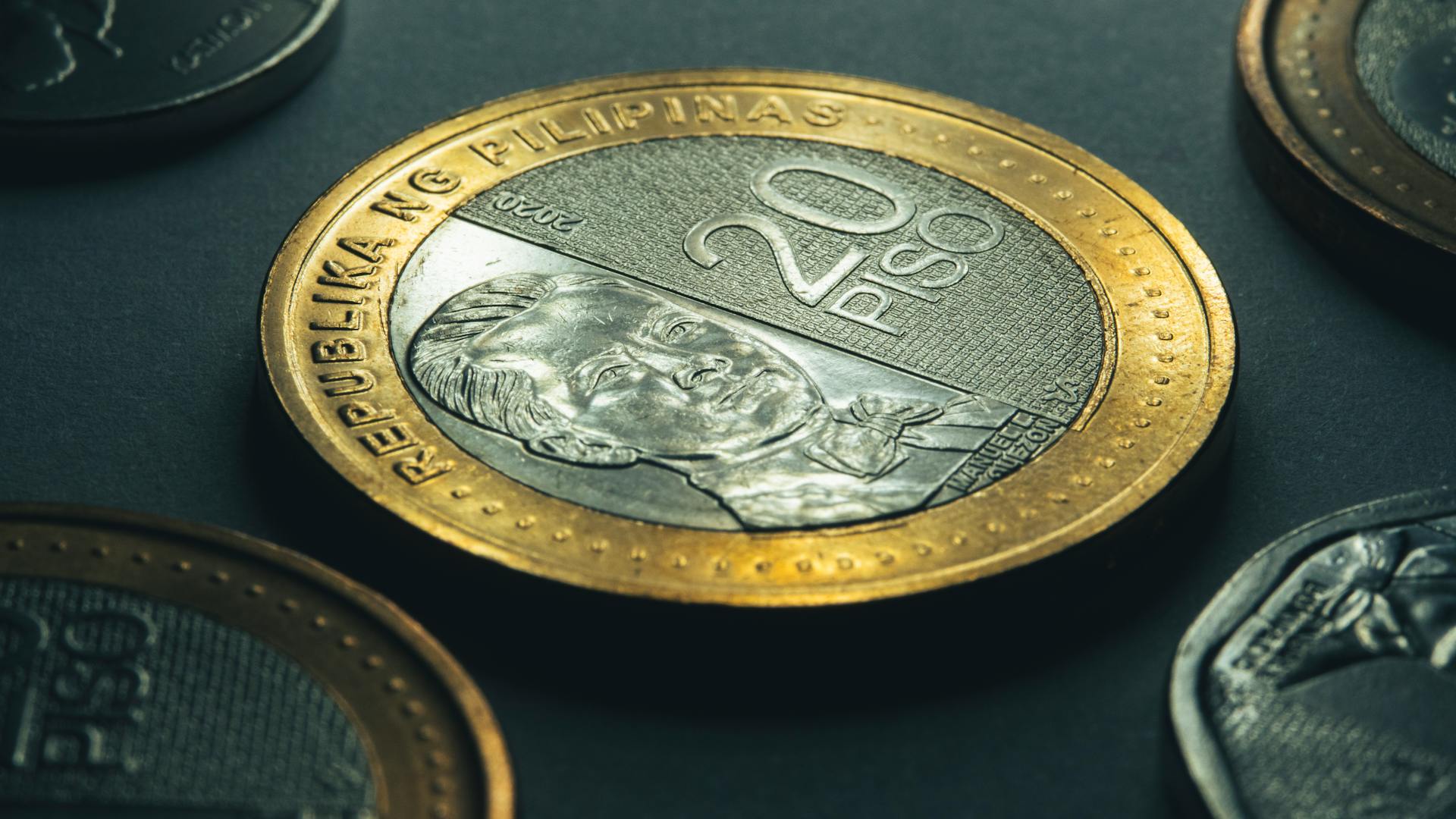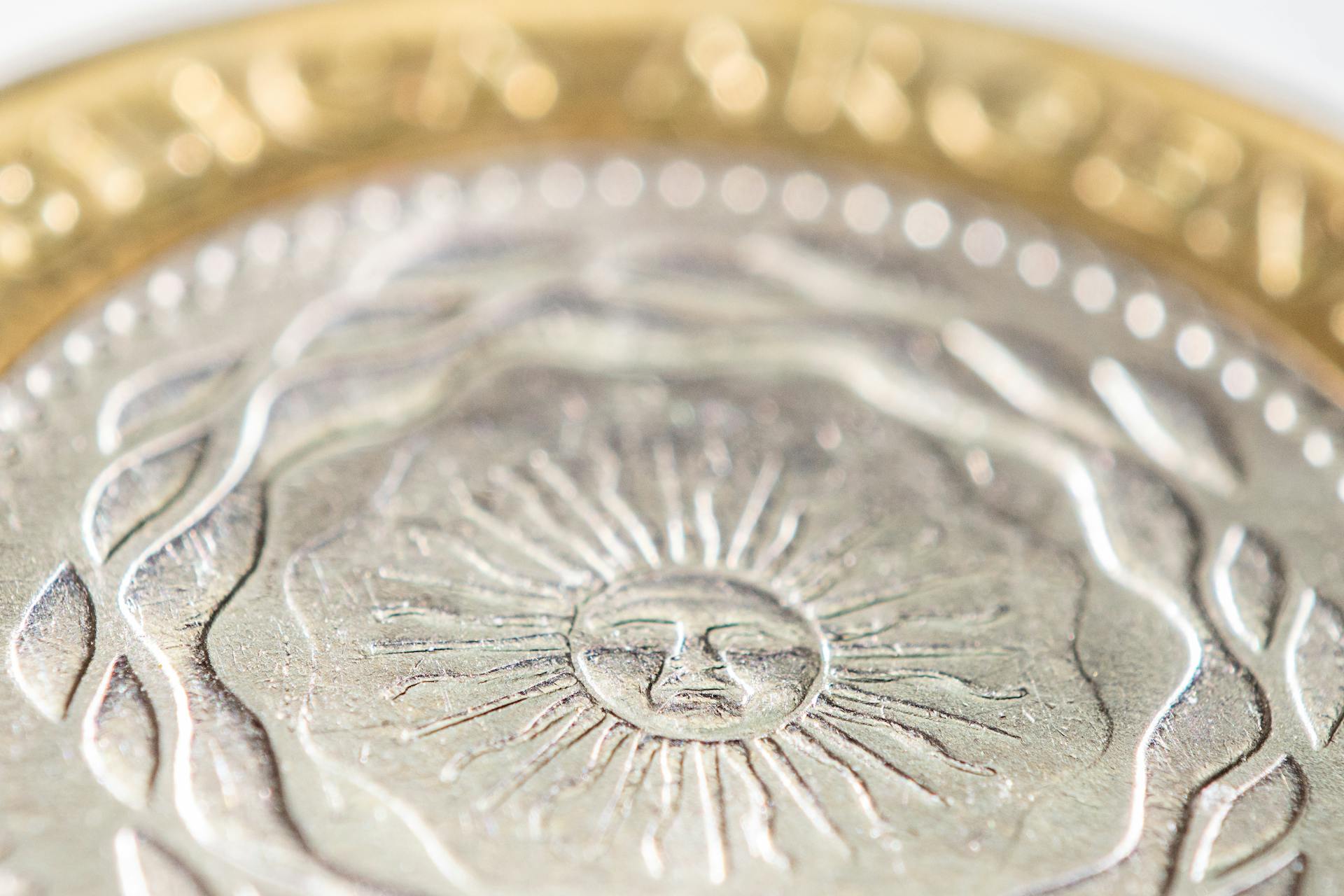
Bimetallism is a monetary system that has been used in various forms throughout history. It's based on the idea of using two metals, typically gold and silver, as a standard for currency.
The use of bimetallism dates back to ancient civilizations, where gold and silver were used as mediums of exchange. The Greeks and Romans used a combination of gold and silver coins, and this practice continued in various forms throughout history.
One of the key characteristics of bimetallism is the use of a fixed ratio between the two metals. For example, in the United States, the Coinage Act of 1873 established a ratio of 16:1 between gold and silver, meaning that 16 ounces of silver were equivalent to one ounce of gold.
This system was used to stabilize the value of currency and prevent inflation. However, it had its drawbacks, such as the difficulty in maintaining the fixed ratio between the two metals.
See what others are reading: In a Fractional Reserve Banking System Banks Create Money Because
What Is Bimetallism?
Bimetallism is a monetary system where a government recognizes coins made of both gold and silver as legal tender. A bimetallic standard backs a unit of currency to a fixed ratio of gold and/or silver.
In a bimetallic system, the mint ratio is the price of an ounce of gold divided by the price of an ounce of silver, and is the exchange rate between the two precious metals. This ratio is fixed by the government at a particular exchange rate, which can be adjusted over time.
The bimetallic standard was first used in the United States in 1792 as a means of controlling the value of money. One ounce of gold was equal to 15 ounces of silver at the time.
Adequate gold and silver were kept in reserves to back the paper currency. The officially adopted silver-to-gold parity ratio of 15:1 accurately reflected the market ratio at the time.
Take a look at this: Us Currency Gold Standard
History of Bimetallism
The concept of bimetallism dates back to the 7th century BCE, when Asia Minor created a coinage based on electrum, a mix of gold and silver. This early form of bimetallism had a variable value due to the unpredictability of electrum's composition.
In the 19th century, France and the United States adopted bimetallism, with France establishing a bimetallic standard in 1803, valuing gold to silver at 15.5 to 1. The United States followed suit in 1792, with Secretary of the Treasury Alexander Hamilton proposing a 15:1 exchange rate between silver and gold. The Coinage Act of 1792 formalized this ratio, with the proportion slipping to 16:1 by 1834.
The French economy was powered by silver during the 19th century, while gold was exported. The California Gold Rush, however, reduced the value of gold relative to silver, leading to a shift in the market rate. The United States eventually abandoned bimetallism with the Coinage Act of 1873, but not formally outlawed it as legal currency until the early 20th century.
For more insights, see: Coinage Act 1792
Historical Creation
In the 7th century BCE, Asia Minor, specifically Lydia and Ionia, created a coinage based on electrum, a natural mix of gold and silver.
Electrum coins were in use for about 80 years, but their variable composition made them hard to value, hindering their development.
The unpredictability of electrum's value was a major issue, making it difficult to determine its worth.
Before Croesus, his father Alyattes had already started minting various types of non-standardized electrum coins in Lydia and surrounding areas.
The use of electrum coins in Asia Minor laid the groundwork for later developments in bimetallism.
A variable mix of gold and silver, with about 54% gold and 44% silver, made electrum coins a precursor to the bimetallic standards that would follow.
Curious to learn more? Check out: How Is Us Currency Made
Achaemenid Coinage
The Achaemenid Empire's coinage system was a significant development in the history of bimetallism. From around 515 BCE, the minting of Croesids in Sardis was replaced by the minting of Darics and Sigloi.
Darius I initiated a metrological reform, modifying the weight of the Daric. The earliest gold coin of the Achaemenid Empire, the Daric, followed the weight standard of the Croeseid.
Sardis remained the central mint for the Persian Darics and Sigloi. The gold Daric became an international currency, found throughout the Ancient world.
The circulation of the Sigloi, on the other hand, was limited to Asia Minor. Important hoards of Sigloi are only found in these areas, with finds beyond being very limited compared to Greek coins.
United Kingdom
The United Kingdom's experience with bimetallism is a fascinating one. In the 18th century, silver coinage began to be restricted, first informally and then by an Act of Parliament in 1774.
The country's shift to the gold standard was a gradual process. Peel's Bill set the country on the gold standard for the remainder of the century, but advocates of a return to bimetallism continued to appear.
See what others are reading: Bahraini Dinar Which Country
After the crash of 1825, William Huskisson argued strongly within the Government for bimetallism, citing its potential to increase credit and ease trade with South America. His efforts were part of a larger movement that gained strength in the last quarter of the century.
Manchester cotton merchants and City financiers with Far East interests joined the movement, offering a serious challenge to the gold standard. However, their efforts were ultimately unsuccessful in bringing about a return to bimetallism.
Primary Sources
Primary Sources are a treasure trove of information, and for those studying the History of Bimetallism, they're a must-read.
The Democratic Party's National Committee published a handbook in 1896, titled "Campaign Text-book of the National Democratic Party", which opposed Bryan's stance on bimetallism.
In 1896, Robert Giffen wrote "Case against Bimetallism", a book that presented a strong argument against the bimetallic standard.
Joseph Shield Nicholson's book "Money and Monetary Problems" was published in 1897 and offered insights into the complexities of the bimetallic system.
A different take: Renminbi Currency
Here's a list of some key primary sources to explore:
- Campaign Text-book of the National Democratic Party (1896)
- Walker, International Bimetallism (New York, 1896)
- Robert Giffen, Case against Bimetallism (London, 1896)
- Joseph Shield Nicholson, Money and Monetary Problems (London, 1897)
- Samuel Dana Horton, The Silver Pound (London, 1887)
- Walker, Money (New York, 1878)
- Francis Amasa Walker, Money, Trade and Industry (New York, 1879)
- Elisha Benjamin Andrews, An honest Dollar (Hartford, 1894)
- Helm, The Joint Standard (London, 1894)
- Frank William Taussig, The Silver Situation in the United States (New York, 1893)
- Horace White (writer), Money and Banking (Boston, 1896)
- James Laurence Laughlin, History of Bimetallism in the United States (New York, 1897)
- Langford Lovell Price, Money and its Relations to Prices (London and New York, 1896)
- Utley, Bimetallism (Los Angeles, 1899)
- Roger Q. Mills, What shall we do with silver? (The North American Review, Volume 150, Issue 402, May 1890)
These sources offer a range of perspectives on bimetallism, from opposing views to in-depth analyses of the system.
Monetary Systems
In the United States, bimetallism was officially abandoned by the Coinage Act of 1873, but not formally outlawed as legal currency until the early 20th century.
The Coinage Act of 1792 established a fixed exchange rate between gold and silver at 15:1, which was later adjusted to 16:1 in 1834.
The value disparities between the face value of coins and the actual value of the metal they contained led to a severe silver shortage in the United States, prompting the government to debase its silver coinage in 1853.
This debasement effectively turned silver coinage into a fiduciary currency based on its face value rather than its weighted value, making it less attractive as a currency.
The gold standard persisted in the United States until 1933, when the Great Depression caused people to hoard their gold, making the system unstable.
See what others are reading: Does Vatican City Have Its Own Currency
Monetary Systems
In the United States, the bimetallic standard was used from 1792 to 1873, where both gold and silver were recognized as legal currency.
The U.S. fixed the value of silver to gold as 15:1, which was later adjusted to 16:1. This meant that one ounce of gold was worth 15 ounces of silver.
People stopped spending silver coins and opted to sell them or melt them down because the face value of the coins was lower than the actual value of the metal they contained. This resulted in a severe silver shortage.
The U.S. government debased its silver coinage in 1853, lowering the amount of silver in the coins and moving the country towards monometallism and the Gold Standard.
The gold standard was officially adopted in the United States in 1900 with the Gold Standard Act, making gold the only metal that could be converted into paper money.
The gold standard persisted until 1933, when the Great Depression caused people to hoard their gold, making the system unstable.
Take a look at this: Fiat Money vs Gold
The Bretton Woods agreement after WWII forced Allied countries to accept the U.S. dollar as a reserve rather than gold, and the U.S. government pledged to keep enough gold to back its dollars.
In 1971, the Nixon administration terminated the convertibility of U.S. dollars to gold, creating a fiat currency regime.
Latin Monetary Union
The Latin Monetary Union was a treaty signed by France, Belgium, Switzerland, and Italy in 1865, which established a common monetary standard among these countries.
This treaty allowed for unlimited free coinage of gold and silver at the 15.5 to 1 rate used in France, effectively adopting bimetallism.
In 1868, Greece joined the Latin Monetary Union, and about twenty other countries adhered to its standards.
The union began to back away from bimetallism by allowing limited issues of low denomination silver coins struck to a lower standard for government accounts.
A surplus of silver led the Latin Monetary Union to limit free coinage of silver in 1874 and to end it in 1878, effectively abandoning bimetallism for the gold standard.
Recommended read: Usd to Php Exchange Rate Today Western Union
Political Debate
The debate over bimetallism was intense and far-reaching, with supporters and opponents on both sides of the aisle. The Coinage Act of 1873 effectively made the U.S. a Gold Standard country, eliminating the ability to have silver bullion struck into coins.
Supporters of the Gold Standard saw stability in a single metal, gold, that the U.S. had plenty of, allowing it to manipulate its market value and keep prices stable. Many argued that a "monometal" system limited the amount of money in circulation, making it difficult to obtain loans and deflating prices.
The controversy surrounding the Gold Standard led to widespread criticism, with many seeing it as benefiting the banks and the rich while hurting farmers and common people. A Depression and a panic in 1893 crippled the U.S. economy, exacerbating the argument over bimetallism.
The issue came to a head during the 1896 presidential election, where William Jennings Bryan made his famous "Cross of Gold" speech arguing for bimetallism. He gained the nomination but lost the election to William McKinley.
Analysis and Notes
Milton Friedman concluded that abandoning the bimetallic standard in 1873 led to greater price instability, resulting in long-term harm to the US economy.
The bimetallic standard allowed for the use of both gold and silver as a medium of exchange. In fact, domestic animals were also used as commodity money in some cases.
Economic analysis suggests that the abandonment of this standard had significant consequences, including increased price instability.
Consider reading: Silver Spot Price Predictions
Economic Analysis
Milton Friedman concluded that the abandonment of the bimetallic standard in 1873 led to greater price instability than would have occurred otherwise.
The act of 1873 was considered a mistake that had highly adverse consequences for the US economy, according to Friedman's retrospective analysis.
In the past, various commodities were used as mediums of exchange, including domestic animals and representative money.
Here's a breakdown of the different types of mediums of exchange:
Notes
Bimetallic standards have a complex history, with some arguing against and others for their stability and usefulness.
The term "bimetallic" has been used interchangeably with "bi-metallism."
Some economists, like Charles Kindleberger and Angela Redish, have expressed skepticism about the inherent stability of bimetallic standards.
Milton Friedman and Marc Flandreau, on the other hand, have argued in favor of their usefulness.
Frequently Asked Questions
What are the advantages of bimetallic standard?
Bimetallism facilitates international trade by allowing countries to engage with both gold standard and silver standard nations, and eliminates trade restrictions through the free flow of coins. This promotes economic exchange and cooperation across different monetary systems.
Why is bimetallism bad?
Bimetallism can lead to market distortions due to a fixed ratio between metals that may not reflect their true market value. This can cause economic imbalances and inefficiencies in the market.
What was the bimetallism before 1875?
Before 1870, the international monetary system used bimetallism, where both gold and silver coins were used as international modes of payment, with exchange rates determined by their metal contents. This system allowed countries to choose between a gold or silver standard.
Sources
- https://en.wikipedia.org/wiki/Bimetallism
- https://eh.net/encyclopedia/bimetallism/
- https://www.encyclopedia.com/social-sciences-and-law/economics-business-and-labor/money-banking-and-investment/bimetallism
- https://www.investopedia.com/terms/b/bimetallic.asp
- https://www.thoughtco.com/bimetallism-definition-history-4160438
Featured Images: pexels.com

